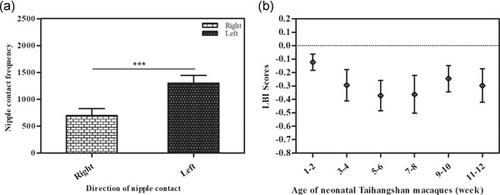当前位置:
X-MOL 学术
›
Am. J. Primatol.
›
论文详情
Our official English website, www.x-mol.net, welcomes your feedback! (Note: you will need to create a separate account there.)
Neonatal nipple preference and maternal cradling laterality in wild Taihangshan macaques (Macaca mulatta tcheliensis).
American Journal of Primatology ( IF 2.4 ) Pub Date : 2020-09-22 , DOI: 10.1002/ajp.23197 Yongman Guo 1, 2 , Paul A Garber 3, 4 , Jundong Tian 1, 2, 5 , Jiqi Lu 1, 2, 5
American Journal of Primatology ( IF 2.4 ) Pub Date : 2020-09-22 , DOI: 10.1002/ajp.23197 Yongman Guo 1, 2 , Paul A Garber 3, 4 , Jundong Tian 1, 2, 5 , Jiqi Lu 1, 2, 5
Affiliation

|
Lateralized behavior is considered an observable phenotype of cerebral functional asymmetry and has been documented in many mammalian species. In the present study, we examined evidence of lateralization in neonatal nipple contact, maternal cradling, and the relationship between these two behaviors during the first 12 weeks of life in wild Taihangshan macaques (Macaca mulatta tcheliensis). The results showed that across our sample of nine mother–infant dyads: (1) Seven of nine neonates exhibited a significant left‐side nipple preference during the first 12 weeks of life, whereas eight of nine mothers displayed a significant right‐side cradling preference; (2) at the population level, there was a significant preference for left nipple contact by neonatal Taihangshan macaques and a significant right‐hand maternal cradling preference; (3) at the population level, there was a nonsignificant negative correlation between neonatal nipple preference and maternal cradling bias; and (4) the strength of individual neonatal nipple preference and maternal cradling laterality were not correlated. We conclude that asymmetry in nipple contact of Taihangshan macaques occurs early in behavioral development. Given that infant Taihangshan macaques are able to nurse and cling unassisted to their mothers within a few days after birth, it appears that the infant rather than its mother is responsible for determining a nipple‐side preference. Our results indicating a left‐side nipple bias in 78% of wild neonatal Taihangshan macaques are most consistent with the heartbeat hypothesis.
中文翻译:

太行山猕猴(Macaca mulatta tcheliensis)的新生儿乳头偏好和母体背侧。
横向行为被认为是大脑功能不对称的可观察表型,并且在许多哺乳动物中都有记载。在本研究中,我们研究了野生太行山猕猴(猕猴)在出生后的头12周内,新生儿乳头接触,产妇的胎侧性以及这两种行为之间的关系的证据。)。结果表明,在我们的9个母婴二倍体样本中:(1)9个新生儿中有7个在生命的前12周内表现出明显的左侧乳头偏好,而9个母亲中有8个表现出显着的右侧乳头偏好; (2)在人口水平上,新生儿太行山猕猴对左乳头接触有明显的偏爱,而右侧产妇对母亲的乳头较偏爱。(3)在人群水平上,新生儿乳头偏爱与母亲的出生偏差之间无显着负相关;(4)个体新生儿乳头偏爱的强度与母亲的胎侧性无关。我们得出结论,太行山猕猴的乳头接触不对称发生在行为发展的早期。鉴于婴儿太行山猕猴在出生后几天内可以在母亲的帮助下进行哺乳和抱抱,看来婴儿而非母亲应负责确定乳头方面的偏爱。我们的结果表明,在野生新生儿太行山猕猴中,有78%的左侧乳头偏斜与心跳假说最为吻合。
更新日期:2020-11-19
中文翻译:

太行山猕猴(Macaca mulatta tcheliensis)的新生儿乳头偏好和母体背侧。
横向行为被认为是大脑功能不对称的可观察表型,并且在许多哺乳动物中都有记载。在本研究中,我们研究了野生太行山猕猴(猕猴)在出生后的头12周内,新生儿乳头接触,产妇的胎侧性以及这两种行为之间的关系的证据。)。结果表明,在我们的9个母婴二倍体样本中:(1)9个新生儿中有7个在生命的前12周内表现出明显的左侧乳头偏好,而9个母亲中有8个表现出显着的右侧乳头偏好; (2)在人口水平上,新生儿太行山猕猴对左乳头接触有明显的偏爱,而右侧产妇对母亲的乳头较偏爱。(3)在人群水平上,新生儿乳头偏爱与母亲的出生偏差之间无显着负相关;(4)个体新生儿乳头偏爱的强度与母亲的胎侧性无关。我们得出结论,太行山猕猴的乳头接触不对称发生在行为发展的早期。鉴于婴儿太行山猕猴在出生后几天内可以在母亲的帮助下进行哺乳和抱抱,看来婴儿而非母亲应负责确定乳头方面的偏爱。我们的结果表明,在野生新生儿太行山猕猴中,有78%的左侧乳头偏斜与心跳假说最为吻合。


























 京公网安备 11010802027423号
京公网安备 11010802027423号